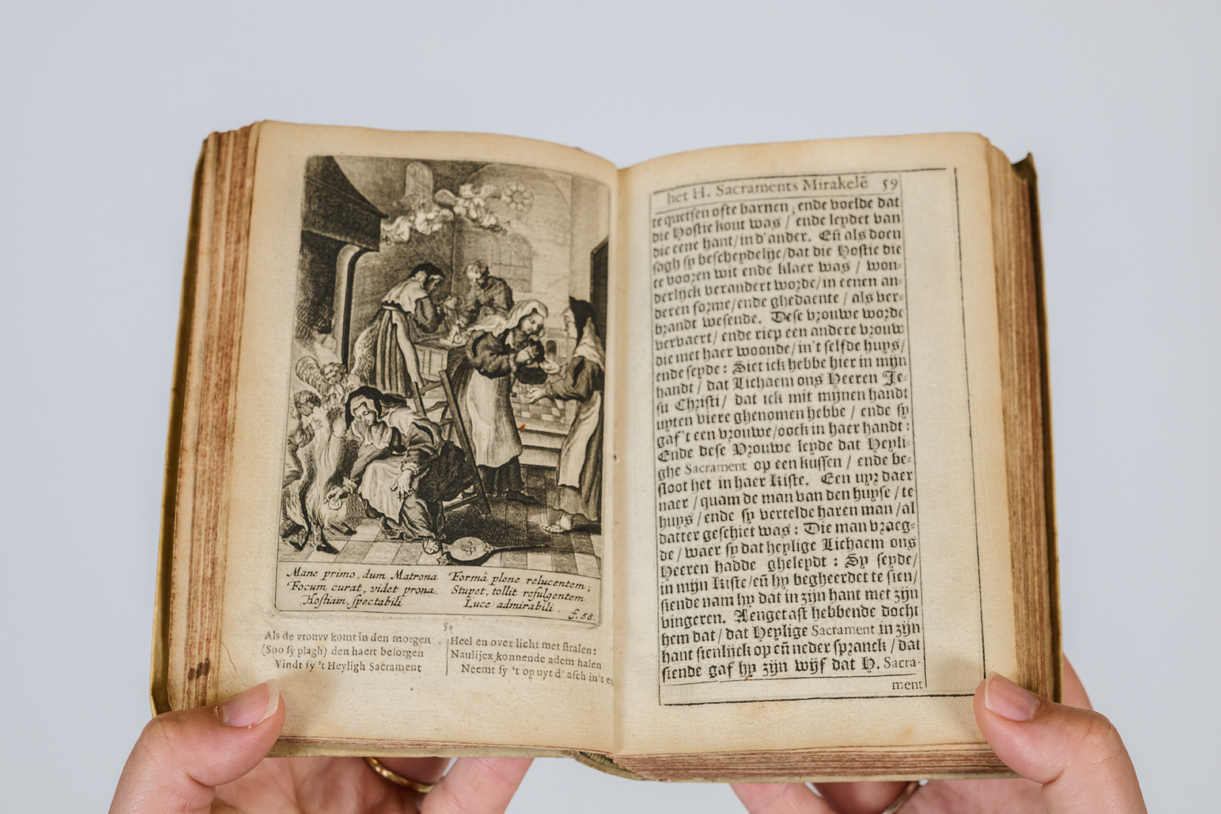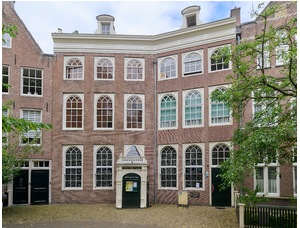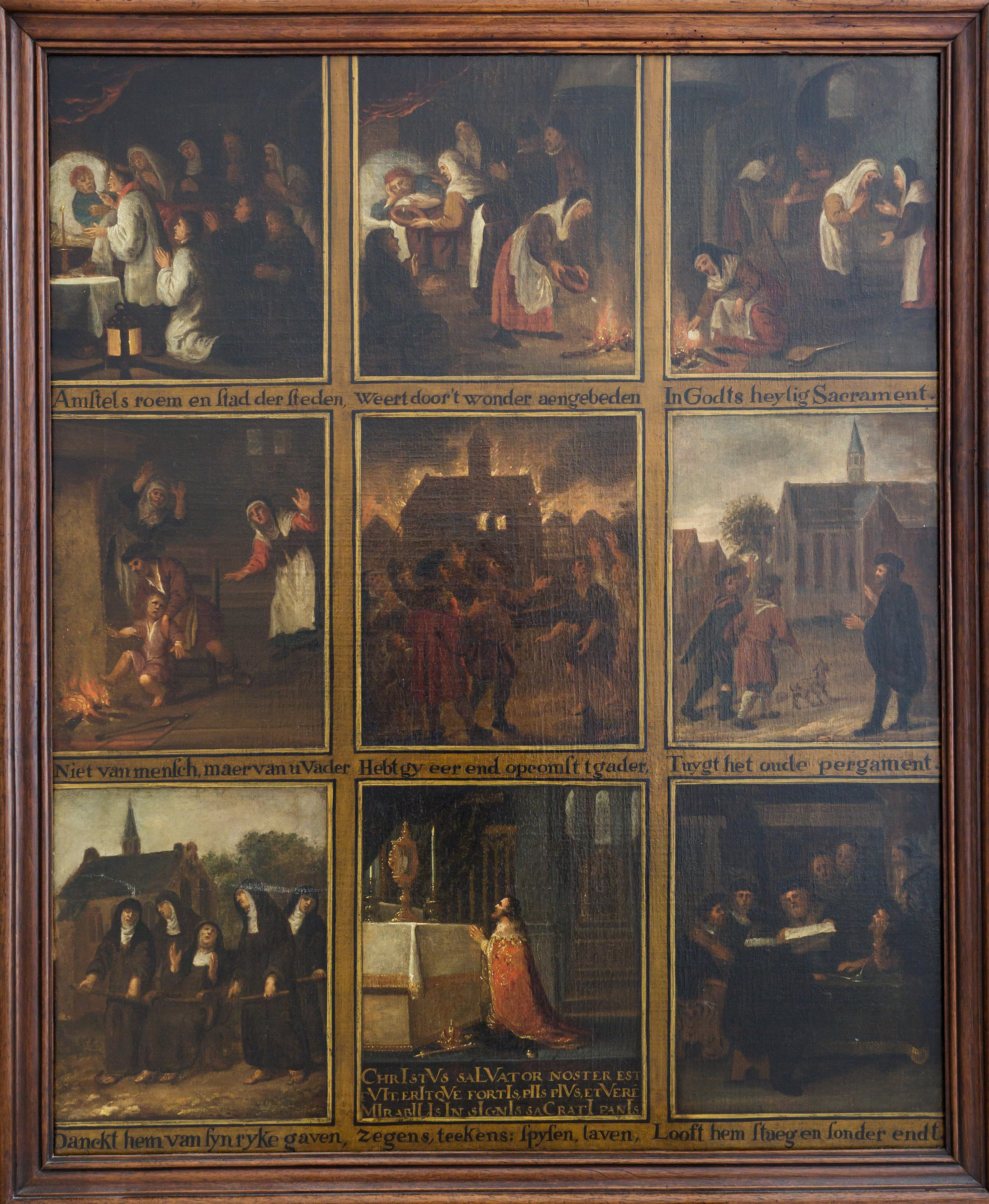One generation after the Protestant takeover of the city, the pastor of the Begijnhof writes a book that saves the Catholic tradition of the Miracle of Amsterdam from its downfall.
Location
Chapel of St John and St Ursula (Chapel of the Beguinage)
Nieuwezijds Voorburgwal
Type
Clandestine church
Religious community
Roman Catholic Church
Object
Book with texts and prints about the Miracle of Amsterdam
Maker and date
Leonardus Marius
1639
Visit
The book is not available for viewing
The miraculous host has been replaced for decades; we have been fooled! If the host can withstand the hearth fire, why can it spoil? What a silly superstition! Down with all this Papal idolatry in the church!
After the Alteration of Amsterdam (1578), the city is turned upside down. One by one, the former Catholic churches and monasteries are stripped of their altars, relics, works of art ánd traditions. The Protestant purge of the Heilige Stede (i.e. holy place), the site of the 1345 Miracle of Amsterdam, is perhaps the most harrowing. Once the chapel was the religious heart of the city, now the public veneration of the Miracle is forbidden.
Alteratie
In 1578, the Catholic city government of Amsterdam was deposed. A Protestant city council took its place. The consequence of this change (Alteratie in Dutch) was that, from that moment on, the Reformed Church became the only church that was allowed to manifest itself publicly. Catholic churches and monasteries were confiscated and given new functions.
Host
From the Latin word hostia, meaning sacrifice, is bread used during the Catholic Mass. It is usually shaped like a round piece of unrisen bread, referring to the unrisen bread which Jesus Christ used at the Last Supper. Catholicism teaches that the host, along with wine, are transformed during holy mass into the body and blood of Jesus Christ through the words of a priest. This is called consecration. The consecrated hosts are also called the Blessed Sacrament.
Miracle of Amsterdam
The Miracle of Amsterdam took place in 1345 in a house on Kalverstraat. After a dying man could not keep down his last Holy Communion, a maid threw the vomit with the Blessed Host into the fireplace. The Host was found intact in the fireplace the next day. They concluded that God was present here in a special way and that He wanted to be worshipped in the Blessed Host at this location. Shortly afterwards, they built a pilgrimage chapel at the same location, which was called the Heilige Stede (Holy Place). This chapel was demolished in 1908.
Catholics face uncertain times ahead. Since the practising of their faith is banned, they gather in hidden churches. In those hidden churches, they proudly sing about the Miracle of Amsterdam and the Heilige Stede.
Praise be to God's strong hand
Who once, in times of yore,
Held Moses’ bush inviolate by flames
Now preserves its Sacrament
Ask ye here for proof!
There in the Holy Place at Amsterdam
The most pious people
testify that my song is true
For the learned parish priest of the Beguinage's shelter church, Leonardus Marius (1588-1652), this covert singing about the Miracle is not enough. He publishes a book in 1639 defending the belief in the Miracle of Amsterdam. The title of the book, Amstelredams eer ende opcomen (Amsterdam’s glory and ascendency), is significant. According to Marius, the Miracle of Amsterdam is the cause of Amsterdam's rise.
hidden church
Building in which hidden religious services were held in the Dutch Republic (1588-1795). Christian denominations outside the Calvinist church, such as Catholics, Lutherans, Mennonites and Remonstrants, had to practice their religions in hidden churches.
Yet this is not the main message Marius wants to convey to his contemporaries. His book is a true spiritual reading, urging the faithful in Eucharistic devotion (i.e. the belief that the consecrated host is truly the body of Jesus Christ and should be worshipped). From this perspective, belief in the Miracle is not at all a silly superstition, but goes to the heart of the Catholic faith. For this reason, it is extremely important to Marius that the Miracle tradition be passed on in Amsterdam.
The book is a great success. Marius' text and the accompanying engravings by Boëtius à Bolswert (1580-1633) have a lasting influence on thinking about and depicting the Miracle of Amsterdam.
Pieter-Jan van Giersbergen
Curator Our Lord in the Attic Museum
Last edited
March 12, 2025
Marius,L., Amstelredams eer ende opcomen, door de denckwaerdighe miraklen aldaer geschied, aen ende door het H. Sacrament des Altaers Anno 1345 (Antwerpen 1639). Collection Museum Ons’ Lieve Heer op Solder.
Exterior and interior: photography Robert Westera
Leonardus Marius Goezanus, pastoor van de Begijnhofkerk, Nicolaes Moyaert, 1647, Oil on panel. Collection Museum Ons’ Lieve Heer op Solder.
Negen taferelen van het Mirakel van Amsterdam, naar gravures van Boëtius à Bolswert, maker unknown, c. 1790, oil on canvas. Collection Museum Ons’ Lieve Heer op Solder.
Caspers, Charles, en P. J. Margry, Het mirakel van Amsterdam: biografie van een betwiste devotie (Amsterdam 2017).
Marius, L., B., Amstelredams eer ende opcomen door de denckwaerdighe miraklen aldaer geschied aen ende door het H. Sacrament des Altaers Anno 1345 (Antwerpen 1639).









